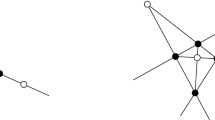Abstract
We study the structure of planar point sets that determine a small number of distinct distances. Specifically, we show that if a set \(\mathcal{P}\) of n points determines o(n) distinct distances, then no line contains Ω(n 7/8) points of \(\mathcal{P}\) and no circle contains Ω(n 5/6) points of \(\mathcal{P}\).
We rely on the partial variant of the Elekes-Sharir framework that was introduced by Sharir, Sheffer, and Solymosi in [19] for bipartite distinct distance problems. To prove our bound for the case of lines we combine this framework with a theorem from additive combinatorics, and for our bound for the case of circles we combine it with some basic algebraic geometry and a recent incidence bound for plane algebraic curves by Wang, Yang, and Zhang [20].
A significant difference between our approach and that of [19] (and of other related results) is that instead of dealing with distances between two point sets that are restricted to one-dimensional curves, we consider distances between one set that is restricted to a curve and one set with no restrictions on it.
Similar content being viewed by others
References
M. Charalambides: Exponent gaps on curves via rigidity, in: arXiv:1307.0870.
J. Cilleruelo, M. Sharir and A. Sheffer: On lattices, distinct distances, and the Elekes-Sharir framework, in arXiv:1306.0242.
D. Cox, J. Little and D. O’Shea: Ideals, Varieties, and Algorithms: An Introduction to Computational Algebraic Geometry and Commutative Algebra, 3rd edition, Springer-Verlag, Heidelberg, 2007.
G. Elekes: A note on the number of distinct distances, Period. Math. Hungar. 38 (1999), 173–177.
G. Elekes: Sums versus products in number theory, algebra and Erdős geometry, Paul Erdős and His Mathematics II, János Bolyai Math. Soc., Budapest, 2002, 241–290.
G. Elekes, M. Nathanson and I. Z. Ruzsa: Convexity and sumsets, J. Number Theory 83 (2000), 194–201.
G. Elekes and L. Rónyai: A combinatorial problem on polynomials and rational functions, J. Combinat. Theory Ser. A 89 (2000), 1–20.
G. Elekes and M. Sharir: Incidences in three dimensions and distinct distances in the plane, Combinat. Probab. Comput. 20 (2011), 571–608.
P. Erdős: On sets of distances of n points, Amer. Math. Monthly 53 (1946), 248–250.
P. Erdős: On some problems of elementary and combinatorial geometry, Ann. Mat. Pura Appl. 103 (1975), 99–108.
P. Erdős: On some metric and combinatorial geometric problems, Discrete Math. 60 (1986), 147–153.
L. Guth and N. H. Katz: On the Erdős distinct distances problem in the plane, in arXiv:1011.4105.
L. Li and O. Roche-Newton: Convexity and a sum-product type estimate, Acta Arith. 156 (2012), 247–255.
H. Kaplan, J. Matoušek and M. Sharir: Simple proofs of classical theorems in discrete geometry via the Guth-Katz polynomial partitioning technique, Disc. Comp. Geom. 48 (2012), 499–517.
J. Pach and P. K. Agarwal: Combinatorial Geometry, Wiley-Interscience, New York, 1995.
J. Pach and M. Sharir: On the number of incidences between points and curves, Combinat. Probab. Comput. 7 (1998), 121–127.
J. Pach and F. de Zeeuw: Distinct distances on algebraic curves in the plane, arXiv:1308.0177.
M. Sharir and J. Solymosi: Distinct distances from three points, in arXiv:1308.0814.
M. Sharir, A. Sheffer and J. Solymosi: Distinct distances on two lines, J. Combinat. Theory Ser. A 120 (2013), 1732–1736.
H. Wang, B. Yang and R. Zhang: Bounds of incidences between points and algebraic curves, arXiv:1308.0861.
Author information
Authors and Affiliations
Corresponding author
Additional information
The first author was partially supported by Grant 338/09 from the Israel Science Fund and by the Israeli Centers of Research Excellence (I-CORE) program (Center No. 4/11). Work by the second author was partially supported by the Department of Defense through the National Defense Science & Engineering Graduate Fellowship (NDSEG) Program. Work by the third author was partially supported by Swiss National Science Foundation Grant no. 200021-513047.
Rights and permissions
About this article
Cite this article
Sheffer, A., Zahl, J. & de Zeeuw, F. Few distinct distances implies no heavy lines or circles. Combinatorica 36, 349–364 (2016). https://doi.org/10.1007/s00493-014-3180-6
Received:
Published:
Issue Date:
DOI: https://doi.org/10.1007/s00493-014-3180-6




